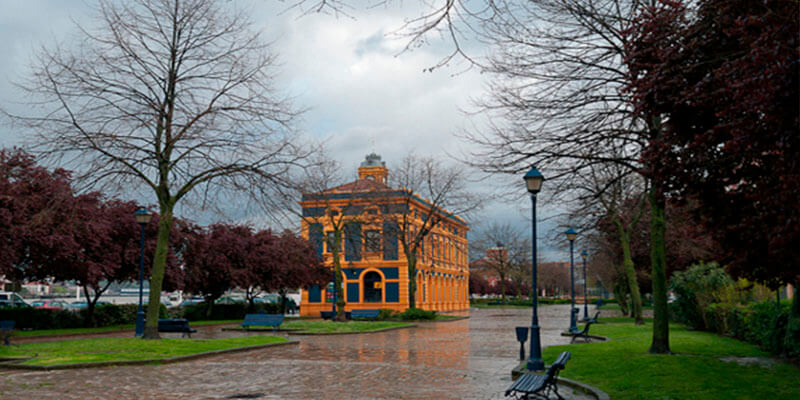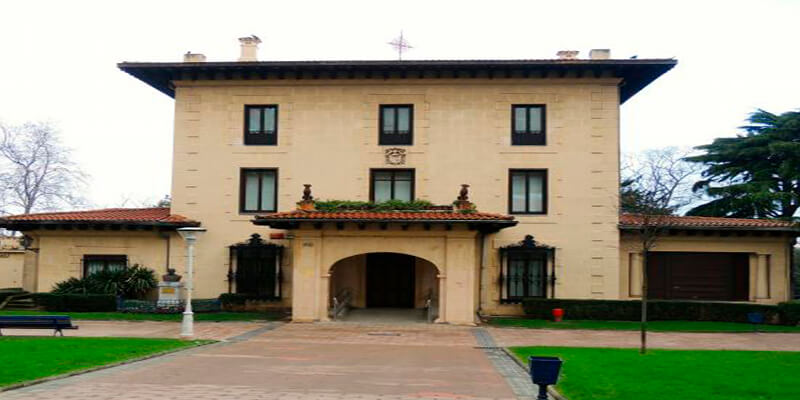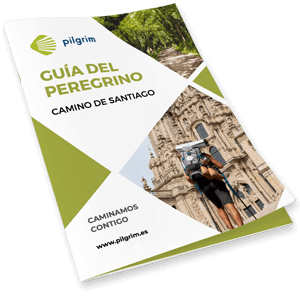Portugalete
‹ Back to the stage
Portugalete
- Residents: 47.117 aprox.
- Province: Bizkaia
Information
Get to know Portugalete
Portugalete is located in the region of the Left Bank, although being only fifteen kilometers from the city of Bilbao is considered to be in the metropolitan area of that city.
There are many legends about the origin of the name of the town, although none is proven the one that has more followers is the one that says that the town must have been called Ugalete or Ugaleta and that with the arrival of the Romans put Portu in front.
<pLocation
How to get there
To reach this town the easiest option is to take the AP-8 highway, which connects A Coruña with Irún. In addition to the village reach the secondary roads BI-628 and BI-3739.
By public transport thanks to the bus lines that connect the village with the main cities of the Basque Country is also possible to reach. Finally, you can also reach Portugalete by train, there is a railway line that connects the town with the city of Bilbao.
History / Culture
What to see
Basílica de Santa María
The Basilica of Santa Maria was built in 1492 with a Gothic-Renaissance style over another one that presents simplicity, wooden cover and a Gothic image of the Virgin which is preserved today. The appearance that we can see today was acquired in the reform that took place in 1691 since the basilica had been destroyed in the last Carlist War, 1874.
The Basilica of Santa Maria was built in 1492 with a Gothic-Renaissance style over another one with simplicity, wooden cover and a Gothic image of the Virgin, which is preserved today.
This temple is characterized by having three naves and an octagonal apse and on the outside of the church you can see two gargoyles of medieval origin resting on the buttresses representing fantastic animals.

Casa Consistorial
The town hall of Portugalete is located in an old historic building built in 1883 by the architect Atanasio Anduiza and renovated and expanded in 1985 with the intention of making better use of the space. The Town Hall has a neoclassical style and consists of a rectangular floor plan and porticoed first floor of distinguished austerity.
At present, the most notable features of the building are decorative motifs, such as the wrought iron railings of the balconies, the Corinthian columns attached to the facade and the coat of arms that can be seen on the cornice of the Noble Villa.
HOURS
Monday to Friday from 08:00 to 14:00
INFORMATION OF INTEREST
Telephone: 944 729 200

Conjunto del casco viejo
The old town of Portugalete was located within the walls that protected the town in the Middle Ages, so it is assumed that in it are the most important buildings both historically and culturally, such as the Church of Santa Maria, the Convent of Santa Clara or the Tower of Salazar. Thanks to this, the Old Town of Portugalete was declared a Historic-Artistic Site.

Convento de Santa Clara
The Santa Clara Convent of baroque style was founded in 1614 and acquired by the City Council in 1987. The highlight of this monument on the outside is the main facade of Renaissance-Plateresque style which is dominated by a triumphal arch with pilasters and topped in a niche with the figure of Santa Clara.
At present the building was conditioned with the intention of hosting the Cultural Center of the Villa and the old cloister was transformed into a garden area and an amphitheater.
HOURS
Monday and Friday from 8:00 to 21:30h Saturday and Sunday according to scheduleThe month of July and December 24 and 31 from 8:00 to 15:00From 21 to 30 December from 8:00 to 20:30August closed

Puente Bizkaia
The Bizkaia Bridge also known as the Suspension Bridge was built in 1893 by Alberto Palacio and in 2006 declared a World Heritage Site for being the first ferry bridge composed entirely of metal structures.
As for its structure, it is supported on four towers connected to each other by a 160-meter-long crossbeam that stretches between Portugalete and Getxo. This large crossbeam stands out for its striking red color used by the miners in the area.
In order for the visitor to learn more about this unique building,
TARIFAS
Guided tours with audio guides in four languages (Spanish, Basque, French and English): €9
.

Estación de la Canilla
The old station of La Canilla is located in the Muelle Viejo next to the Paseo de La Canilla. This classic style building was built in the late nineteenth century in order to create the Bilbao-Portugalete railroad station.
The station was built in the late nineteenth century in order to create the Bilbao-Portugalete railroad station.
At present the station is no longer in operation but the building houses the Tourist Office, the Department of Economic Promotion and Employment and the delegations of the Department of Procurement and Purchasing.
<p
Gran Hotel Puente Colgante
The three-star Gran Hotel Puente Colgante is located in a historic nineteenth century building that was completely rebuilt, although as you can see, the facade has been preserved.
The three-star Gran Hotel Puente Colgante is located in a historic nineteenth century building that was completely rebuilt, although as you can see, the facade has been preserved.
As its name suggests, the Gran Hotel Puente Colgante is located in the vicinity of the Bizkaia Bridge, declared a World Heritage Site by UNESCO. The hotel offers a total of 74 rooms with privileged views of the sea and the Bilbao estuary.
INFORMATION OF INTEREST
.Telephone: 944 014 800

Kiosko de la Música
The Kiosko de la Música is an eclectic style building built in 1912 by Emiliano Pagazaurtundua in the Plaza del Solar. The name Kiosko de la Música comes from the fact that in the past this place used to host Sunday concerts and festivals in which the Municipal Band of Music participated.
The Kiosko de la Música is an eclectic style building built in 1912 by Emiliano Pagazazaurtundua.
At present, the kiosk is a meeting place where every Tuesday, Thursday and Saturday of the year an open-air market known as “El Mercado de las aldeanas” is set up in the vicinity, where you can buy flowers and farm produce.
<p
Mareómetro
The tide gauge is a testimonial nautical instrument located at the end of the Iron Pier. It was manufactured in Paris and installed there by the Board of Works of the Port around 1883.
This instrument measures the depth of the channel, noting the rise and fall of the water level of the tides, something indispensable in its time so that ships could cross the mouth and thus save the dreaded sand barrier of Portugalete.

Monumento a Victor Chavarri
Víctor Chávarri was for Portugalete an important character who greatly favored the development of the economy and politics of the Basque Country in the late nineteenth century so Miquel Blay built a monument in his honor in 1903 in the Plaza del Solar.
Víctor Chávarri was an important figure for Portugalete who greatly favored the development of the economy and politics of the Basque Country in the late nineteenth century so Miquel Blay built a monument in his honor in 1903 in the Plaza del Solar.
Its structure is based on the bust of Víctor Chávarri surrounded by the bodies of two workers, representing those who worked thanks to him.

Muelle de Hierro
The Iron Pier was built between 1881 and 1887 by the engineer Evaristo Churruca with the intention of putting an end to the accidents and shipwrecks that were occurring in the area. As for its structure, it expands for a total of 800 meters of which only six hundred are made of iron and the remaining two hundred of stone.
<pThis pier facilitated the development of the activity of the port of Bilbao, quickly becoming one of the safest in Spain. Today it is very popular with local residents thanks to the promenade that houses and the beautiful views of the estuary and the Suspension Bridge.

Museo de la Industria
The Museum of Industry began to be built in 1993 and was not inaugurated until January 31, 2006. This space is shaped as a historical-artistic place that aims to disseminate and recover the remains of the industrial past of the Basque Country.
Today the museum has a cultural facility that aims to become a benchmark in the region since it has a large number of collections, among which are the following:
In addition, some conferences, workshops and auditions are also held.

Palacio Lexarza
The Lexarza Palace was built in the 19th century in the Doctor Areilza Park, where the Chapel and the San Ignacio de Loyola House of Spiritual Exercises are also located, the three form a beautiful Neoclassicism ensemble.
The Lexarza Palace was built in the 19th century in the Doctor Areilza Park, where the Chapel and the San Ignacio de Loyola House of Spiritual Exercises are also located.
This monument has a quadrangular floor plan with three floors and is surrounded by extensive and beautiful gardens. Also noteworthy is the coat of arms belonging to the lineage of Lexarza and can be seen in the center of the facade.

Parque del Doctor Areilza
The Doctor Areilza Park was founded around 1913 by Emiliano Pagazaurtundua and is located on a spectacular sandy area. Currently, the park is a beautiful botanical garden where a great variety of foreign species, banana trees and conifers abound. This space was created with great detail for the enjoyment of the Bilbao bourgeoisie of the twentieth century.

Paseo de la Canilla
The Paseo de la Canilla is ideal for any visitor to learn more about the town of Portugalete. It is a landscaped promenade that runs parallel to the estuary and in the center of which is located a beautiful fountain presided over by four sculptural figures made of marble symbolizing the four seasons. At the end of the promenade the visitor can contemplate a bronze sculpture that simulates the struggle of man to channel the estuary.

Torre de Salazar
The Salazar Tower was an old house-tower dating back to the 15th century and owned by the Salazar family which was built at the end of the 15th century and later rebuilt around 1958 thanks to the architect Joaquín de Yrizar.
The Salazar Tower was built at the end of the 15th century and later rebuilt around 1958 thanks to the architect Joaquín de Yrizar.
In 2003 the City Council acquired the tower and rebuilt it with the intention of using it for cultural purposes, so that today the tower-house houses a museum where visitors have the opportunity to see a variety of documents and exhibits on the history of Portugalete and Salazar. In addition, this space is also used for temporary exhibitions and has a restaurant.
HOURS
Tuesdays to Fridays from 17:30 to 20:30Saturdays from 11:00 to 14:00 and from 17:30 to 20:30Sundays and holidays from 11:00 to 14:00
Saturdays from 11:00 to 14:00 and from 17:30 to 20:30.

Information of interest
Local police
944 729 292
Civil guard
944 837 347
Fire department
944 061 200
Civil protection
629 117 907
Town hall
944 729 200
Health center
946 007 660 / 946 007 500
Tourism office
944 729 314
Paseo de la Canilla s/n

We send you your itinerary
Enter your details and receive your travel itinerary by email
Recommended
Gastronomy
Recommended
Festivals and Pilgrimages
Local festivity
15 al 17 de agosto: Fiestas de San Roque
Local festivity
10 de julio: Día de Santo Tomás
Local festivity
13 de junio: Fiesta de San Antonio de Padua
Local festivity
1 de julio: Festividad de la Virgen de la Guía
Local festivity
Octubre: Fiesta del barrio de Azeta
Local festivity
4 de septiembre: Fiesta de San Nicolás
Local festivity
A mediados de Septiembre: Fiesta de la Cruz
Local festivity
25 de julio: Festival internacional de folclore
Northern Way
On foot
34 stages




































